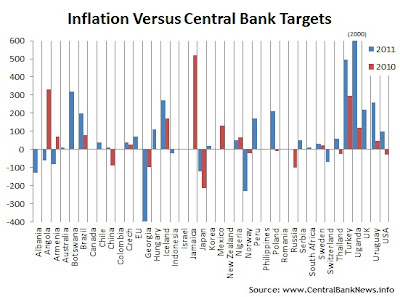This report provides an update on where inflation is tracking in countries where the central bank has an inflation target. Central Bank News has compiled a table of countries/central banks that have publicly announced an official inflation target. In some cases the target is a government target, but in many cases it is one of the central bank’s key performance indicators. Of the 39 countries which have inflation targets that Central Bank News is monitoring; 22 last reported inflation above target, 8 had inflation below target, and 9 reported inflation within their target range. Note, the inflation figures in the table below are all on a headline, or gross, inflation basis.
Of those that saw inflation above target, the standouts were Uganda (27% vs target 7%), Turkey (10.5% vs target 5.5%), Botswana (9.2% vs target range 3-6%), Iceland (5.2% vs 2.5%), and Uruguay (8.6% vs target range 4-6%). Of those with inflation below target, the standouts were Georgia (2% vs target 6%), Norway (0.2% vs target 2.5%), Albania (1.7% vs target 3%), Japan (-0.2% vs target 1%), and Switzerland (-0.7% vs target range 0-2%).
The chart below shows the change in inflation versus target, between the most recently reported inflation figures and the end of 2010 inflation figures (from the IMF). Of the 39 countries, 23 saw inflation go above target, or go higher above target, 10 saw inflation falling closer to target (2 fell into target range), while 6 saw inflation staying within target, and 5 saw inflation fall below target.
Compared to the previous report on inflation vs target as of June 2010, inflation momentum against target has slowed and in some cases reversed. This trend lines up with the themes noted in the Global Interest Rate Movements in 2011 report, which noted an increasing shift to monetary policy easing biases. The trend of waning inflation impulse vs target is likely to be welcomed by many as the threat of economic and financial market disruption from the European sovereign debt crisis persists and as global growth decelerates somewhat, as lower inflation readings compared to targets will allow greater policy flexibility.
However, the threat of a resurgence in inflation cannot be discounted either, particularly as some central banks have engaged in significant balance sheet expansion (e.g. ECB, Bank of England, Swiss National Bank, Bank of Japan, and the US Federal Reserve). Indeed, if further rounds of significant quantitative easing are undertaken, the unintended consequence may well be a rise in commodity price inflation, which for lesser-developed nations has a more direct flow through to general inflation.
But for the first half of 2012 at least, it appears that globally, on balance, the economic growth risks are skewed more to the downside than the upside; and the same can be said of the inflation outlook. Thus this half is also likely to see further policy easing on average. The second half of 2012 will likely be a distinctly binary set of scenarios that depend on the absence or otherwise of event risk and further deterioration of global growth momentum; for now the risks appear to be finely balanced.
What is inflation targeting?
Inflation targeting is an often cited goal of monetary policy, alongside other goals such as maximizing GDP growth, optimal employment, and financial stability. While there is some debate about the merits of inflation targeting, the benefits often cited of explicit inflation targeting include greater certainty and transparency of central bank interest rate decisions, price stability, and ultimately a lower neutral interest rate, provided inflation can be contained within a reasonable range. See the Wikipedia entry on inflation targeting for a summary of the issues and debate on explicit inflation targeting in monetary policy.
Source: www.CentralBankNews.info
Article source: http://www.centralbanknews.info/2012/01/central-bank-inflation-targeting-report.html


